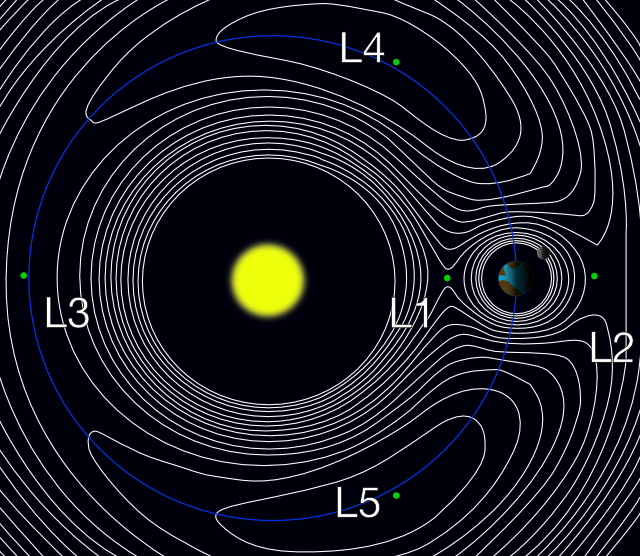In a system of two bodies, where one mass is much larger than the other (such as the Sun and Earth, or the Earth and Moon), there are five points, known as the Lagrange points, where the resultant gravitational field is such that it provides the centripetal force for that object to remain in constant orbit with those two bodies.*
What this means is that an object – such as a satellite – placed at a Lagrange point will remain at that point (relative to the two bodies) without need for any external force such as that provided by rocket or ion thrusters.
For example an object placed at point L1 in the diagram below will always remain between the Earth and the Sun and an object at L2 will always remain in the Earth’s shadow.

The five Lagrange points of the Sun-Earth system. The white lines are gravitational contour lines: an object in free-fall would trace out a path along one of these contours.
L1
L1 is probably the easiest Lagrange point to understand. In the diagram above the Sun pulls towards the left, and the Earth pulls to the right, and the resultant force is just right to keep it in orbit between the Sun and Earth.
The L1 point is ideal for making observations of the Sun-Earth system as satellites placed here are never in the shadow of either the Sun or the Earth. The SOHO, ACE and WIND satellites are all positioned at L1.
L2
L2 is a good site for space-based observatories as it is almost perfectly protected from solar radiation and doesn’t receive any light pollution from Earth. The Planck telescope is currently at L2, the James Webb Space Telescope is scheduled to be placed there in 2018, and the WMAP and Herschel satellites were also previously positioned there.
L3
No satellites are currently positioned at L3, as it lies about 300 million kilometres from Earth. It has been suggested as a useful site for solar activity monitoring, as it would be able to spot any activity likely to affect Earth (sunspots, etc.) before the side of the Sun containing that activity was pointed towards Earth.
L3 is also popular in science fiction, as a place to “hide” something from Earth. After the development of interplanetary probes we checked and unfortunately there’s nothing there (yet).
L4 and L5
The L4 and L5 points lie at a 60° angle from the Sun-Earth axis, at the furthermost point of an equilateral triangle formed by the Sun and the Earth. Because this point is the same distance from both the Sun and Earth the ratio of their gravitational pulls is the same as if it were at the barycentre of the Sun-Earth system and objects placed there remain stationary. No satellites are currently placed at either point.
The Trojan asteroids are located at the L4 and L5 points of the Jupiter-Sun system. Asteroids are constantly being transferred between the asteroid belt and these two points.
* Lagrange points exist for any two-body system in which one object is much more massive than the other, but I’ll only be looking at the Sun-Earth system.
Would the Lagrangian points solve the problem of keeping in contact with any Mars manned mission (if a communications relay was placed in L5 for example)?
Using satellites at L4/L5 would vastly increase the time to transmit a message to Mars, and the fuel required to keep a satellite there just for a two week period every two years wouldn’t be worth the investment.
If they are stable, why the fuel to keep an object there?
Because other objects exist in space, and space is not a perfect vacuum.
Exactly right. The solar wind also applies a small force and even solar radiation pressure has to be combated as well, however slight they are, over a period of time they produce a noticeable effect.